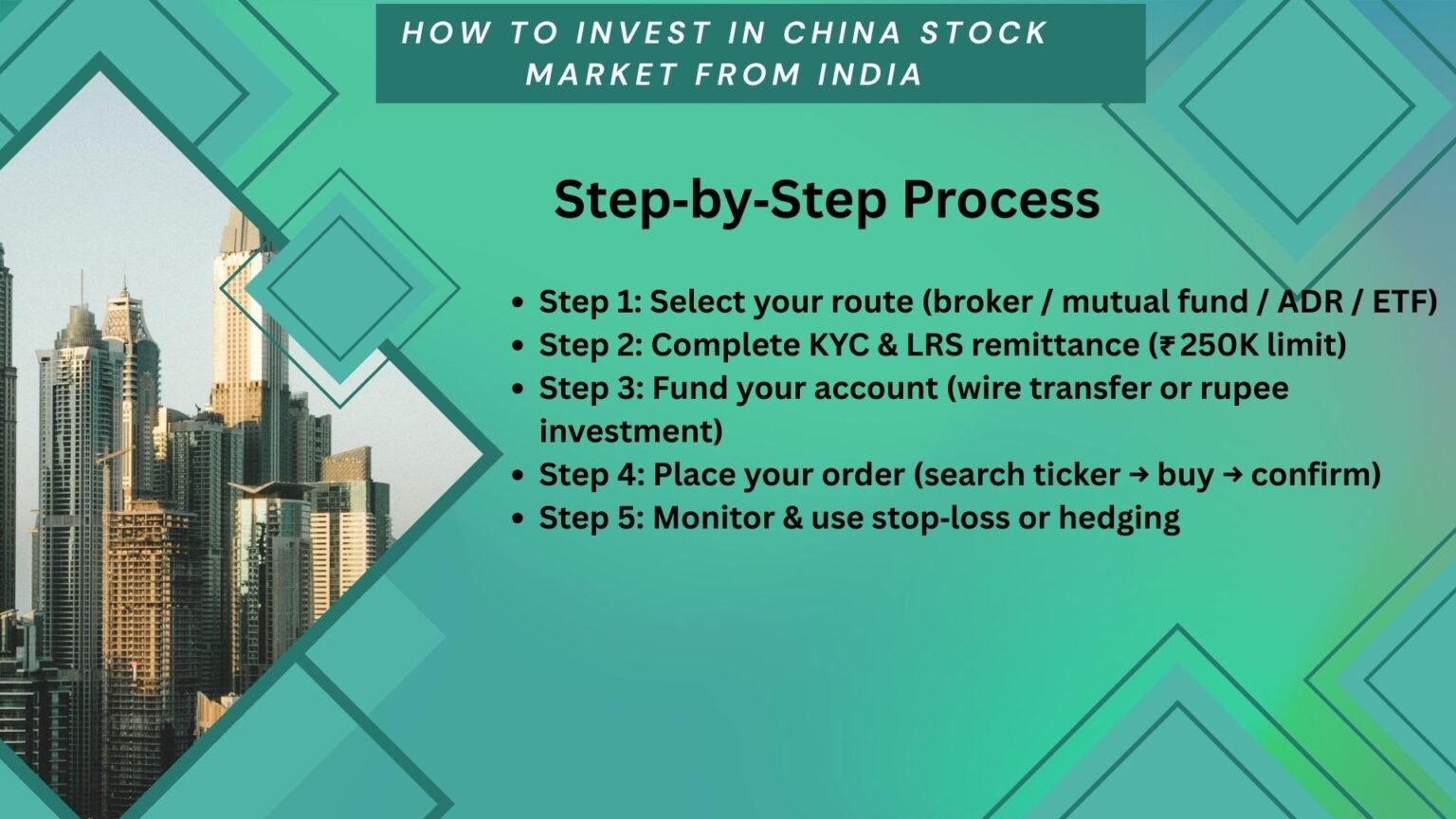Your Guide: Investing in the China Stock Market from India
Why This Matters to You
Heard about Chinese stocks shooting up? 🚀 It's true, they're part of the world's second-biggest economy, and you want a piece of the action! But things like rules, money wibbles (currency ups and downs), and different types of shares (A-shares, H-shares) can seem tricky. Don't worry! This guide will make it simple, help you out, and let you invest like a pro.
1. Learning About the China Stock Market
First, let's see where you can buy these stocks:
1.1 What are the main stock markets?
📈 Shanghai Stock Exchange (SSE)
Home to big, well-known Chinese companies. These are often A‑shares.
💻 Shenzhen Stock Exchange (SZSE)
Famous for new, fast-growing companies, especially tech ones!
1.2 A-shares, B-shares, H-shares: What's the Difference?
It's like different types of game tickets for the same park:
| Share Type | Currency | Who could buy it (mostly)? | Good for you? |
|---|---|---|---|
| A-shares | Chinese Yuan (RMB) | Mostly people in China (but now some ways for others!) | Can be, through special ways. |
| B‑shares | Foreign money (like US Dollars) | People outside China, but not many trade these. | Usually not very popular. |
| H‑shares & ADRs | Hong Kong Dollars (HKD) or US Dollars (USD) | Perfect for investors around the world! | Yes! Often easiest for you. |
1.3 Why This Matters to "how to invest in the China stock market from India"
Knowing this helps you pick the right way to invest. Maybe you want a fund that holds A-shares, or you want to buy H-shares directly. It's like knowing if you want vanilla, chocolate, or strawberry ice cream!
2. Laws and Rules for Indian Investors
India has some rules for sending money out of the country to invest.
2.1 RBI Directives and FEMA Rules
You might ask, "Can I just buy shares from the Shanghai market directly?" Here's the deal:
- Liberalized Remittance Scheme (LRS): You can send up to USD 250,000 (about ₹2 Crores) out of India each financial year for investing.
- FEMA Approval for A-shares: To buy A-shares directly, you usually need to go through a special broker (called a Qualified Foreign Investor) or use mutual funds or ETFs that do it for you.
2.2 Money Limits and Your Money's Value
- Foreign Investment Quotas: Sometimes, there's a limit on how much foreign money can go into certain A-share programs. So, if you're keen, don't wait too long!
- RMB Volatility (Money Wibbles): Your profit doesn't just depend on if the stock price goes up. It also depends on how the Indian Rupee (INR) value changes compared to the Chinese Yuan (RMB). Think about ways to protect against big money wibbles (this is called currency hedging).
3. Four Tested Ways: Step by Step
After this, you'll know exactly how to make your first China stock investment from India!
3.1 Direct Investment via Foreign Brokerages
This is like buying stocks yourself using an international helper.
- Choose a platform: Examples are Interactive Brokers, Charles Schwab, or Saxo Bank.
- Open Your Account: You'll need to show your PAN card, passport (these are KYC documents).
- Fund Your Account: Send money using bank transfer under the LRS rules.
- Place Order: Type in the stock's special code (e.g.,
600519.SSfor Kweichow Moutai), pick if it's an A-share or H-share, and click "Buy."
- You have full control.
- Direct access to Chinese A‑shares and H‑shares.
- Can have higher fees.
- Need to change currencies.
- Sometimes, those quota limits can be an issue.
3.2 Invest in Indian Mutual Funds and ETFs
This is like asking an expert in India to invest in China for you.
Some examples:
- ICICI Prudential China Fund
- Motilal Oswal China Opportunities Fund (Also see: Motilal Oswal NASDAQ 100 ETF)
- Nippon India ETF Hang Seng BeES (Related: Nippon India ETF Nifty Next 50 Junior BeES)
Step by Step:
- Login to your usual Indian investment website (like Groww or Zerodha).
- Search for "China" or "Hang Seng."
- Look at how they've done in the past and how much they charge.
- Click "Invest" and put in how much money you want to invest (one time or a little bit every month - SIP).
- Easy SIP route (invest a bit regularly).
- You invest in Rupees.
- Managed by experts.
- Less choice of individual stocks compared to direct investing.
- You pay a fee to the fund manager.
3.3 Buying ADRs on U.S. Markets
ADRs are like special passes for Chinese company shares that you can buy on American stock markets.
Famous examples: Alibaba (BABA), NIO (NIO), JD.com (JD).
What to do:
- Use your international brokerage account (the one you might use for US stocks).
- Search for the ADR's special code (ticker).
- Buy it using US Dollars, just like any American stock.
- Follows well-known U.S. rules.
- Easy to buy and sell (very liquid).
- Can be affected if U.S. and China have disagreements (political risk).
3.4 Synthetic Exposure from China Index Funds
This is like buying a basket that holds tiny pieces of many different Chinese stocks.
Popular indexes: CSI 300 Index, MSCI China Index.
ETFs like iShares MSCI China ETF (MCHI).
Steps:
- Find the fund's special code (ticker).
- Make sure it's on a stock market you can use.
- Buy it with your foreign broker or through an Indian platform if available.
- Spreads your money across many stocks (diversified).
- Mixes A-shares, H-shares, and ADRs; you have less control over individual picks.
4. Managing Problems and Risks
Investing always has some risks. Here's what to watch out for:
4.1 Market Wibbles (Volatility)
Chinese stocks can go up and down a LOT, very quickly. Think about the Didi (ride-sharing) or Ant Group (money tech) IPOs. Use stop-loss orders to help protect your money if prices fall too much.
4.2 Geopolitical and Rule Changes
- Sudden Rule Changes: Sometimes the government makes new rules that can hit certain types of companies (like education or tech) hard, making their stock prices drop fast.
- Trade Tensions: Arguments between countries like the U.S. and China can affect H-share prices.
4.3 Currency Risk and Hedging (Protecting Your Money's Value)
Remember the RMB money wibbles? If you're worried about the Indian Rupee losing value against the Chinese Yuan, you can look for China ETFs that are "RMB-hedged" or use special bank tools (forex derivatives) to protect your investment's value.
5. Insider Tips for Success 💡
- Stay Updated: Read news from places like Caixin, South China Morning Post, and check RBI updates.
- Don't Put All Eggs in One Basket (Diversify): Mix A-shares, H-shares, ADRs, and mutual funds. Don't just pick one!
- Use SIPs for Mutual Funds: Investing a little bit regularly can smooth out the ups and downs.
- Ask an Expert: A SEBI-registered advisor can help make a plan that's right for you.
- Check In Regularly: Look at your investments every few months to see how they're doing, as China's economy changes fast!
Conclusion: Your Journey to Investing in China!
I hope this guide has made things clearer! Now you know "how to invest in the China stock market from India" – from picking shares to handling rules and risks. The world's second-biggest economy isn't out of reach; it's right here for you.
So, what now? Take a breath, choose your path (A-shares, ADRs, or a China fund in Rupees), and go for it! I'm cheering you on as you grow your investments and grab a slice of China's future. Happy investing! 🎉







